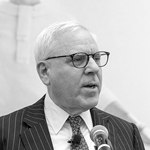Any American who tours Washington, D.C., will get a visual sense of our country’s government – as well as our country’s history – by visiting places like the White House, the Capitol, the Washington Monument, the Lincoln Memorial, the Jefferson Memorial, the Smithsonian Museums, the Library of Congress, the National Archives, the Kennedy Center, or the National Gallery of Art.
Any such American will probably get, as well, a sense that tax dollars are at work supporting these places. And that would largely be true. But, in fact, the U.S. government does not provide all of the funds needed to operate and support any of these buildings. Private contributions are essential, for instance, to keep the Smithsonian’s Museums operating at the level the public has come to expect.
When I worked in the White House as a young man in the late 1970s, I honestly did not focus on the government’s need for regular private support. That lack of focus changed when I heard in 2007 that a rare copy of the Magna Carta was to leave the National Archives, where it had been on loan, to be auctioned at Sotheby’s. “How can that be?” I wondered. “Why would the Archives let the Great Charter of Western democracy escape?” The answer was simple: the National Archives did not have the funds to buy the Magna Carta.
Since the Magna Carta was the inspiration for much of the Declaration of Independence, I resolved to purchase it, and thereby ensure that at least one copy of this rare document would stay in the country.
I was told by Sotheby’s that the most likely prospective buyers were foreigners, and they presumably would move the Magna Carta outside of the U.S. Since the Magna Carta was the inspiration for much of the Declaration of Independence, I simply resolved to try to purchase the Magna Carta, and thereby ensure that at least one copy of this rare document would stay in the U.S. I was fortunate to ultimately prevail at the auction, and I subsequently placed the Magna Carta back at the National Archives, where it will permanently reside.
That purchase spurred me to acquire historic copies of other rare documents – like the Declaration of Independence and the Emancipation Proclamation – and to also place them at other Washington-based institutions unable to afford the originals of these documents. My thinking was that the more Americans who saw these documents, the more they would learn about our history (thereby producing a more informed citizenry).
Just as the Magna Carta sale was unexpected, so too was an earthquake in Washington in 2011. Among the damaged buildings was the Washington Monument. I thought the funds for the repair might not be easy to secure, and thus offered to pay for the repair, hoping that the reconstruction could occur immediately. The offer was accepted, though the National Park Service was ultimately able to pay for half of the repair.
This experience led me to realize that, beyond documents, funds were also not readily available to pay for the routine repairs or restoration of historic monuments or memorials. And so I began an effort to fund this type of undertaking at Monticello, Montpelier, the Lincoln Memorial, the Iwo Jima Memorial, and the Custis-Lee Mansion at Arlington National Cemetery.
I have called this overall type of support of our country’s heritage “patriotic philanthropy” – that is to say, philanthropy designed to help Americans learn more about their historic and cultural heritage.
It is with that same goal that I have also supported an organization whose purpose many Americans may be quite surprised to learn even needs to exist – the White House Historical Association.
There are clearly many worthy organizations that can use support by those interested in pursuing patriotic philanthropy. But the White House Historical Association should be near the top of anyone’s list.
Most Americans probably believe that the most famous house in America is completely funded by the U.S. government. But that is not the case. Jacqueline Kennedy realized this in 1961, as she sought to renovate the furnishings, paintings and other artifacts in this historic home. There were no funds for such a renovation.
So she created the White House Historical Association to enable Americans to contribute to the epic restoration that she was then leading. Mrs. Kennedy famously unveiled the renovations and restoration in a widely watched and admired TV show in 1962.
Since then, each of the other First Ladies have also led redecorations and renovations of the White House. All of those efforts have also been largely supported by the White House Historical Association.
Today, the Association staff is housed in historic townhouses in Lafayette Square, directly across Pennsylvania Avenue from the White House. And the Association operates the nearby White House Visitor Center.
The Association’s privately funded mission is solely to support the effort to ensure that the White House is maintained as an outstanding representation of the best of America’s historic White House culture and traditions. And that is surely a worthwhile mission.
There are clearly many worthy organizations that can use support by those interested in pursuing patriotic philanthropy. But the White House Historical Association should be near the top of anyone’s list.













































